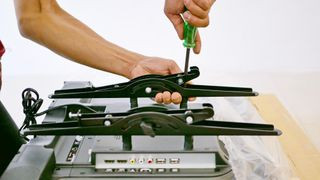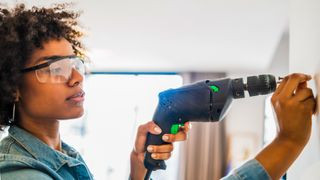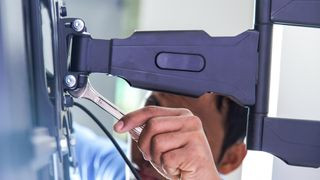
How To Wall Mount A Television: A Step-By-Step Guide?
Are you ready to elevate your viewing experience and create a sleek, modern look in your home theater? Learning How To Wall Mount A Television is the perfect way to do just that, offering a clutter-free aesthetic and optimized viewing angles. At monstertelevision.com, we’re here to guide you through every step of the process, from selecting the right mount to enjoying your favorite monster-filled shows and sci-fi thrillers on your newly mounted screen. Ready to transform your living space? Let’s dive into the world of wall-mounted TVs, exploring key aspects like VESA compatibility, stud finders, and cable management.
1. Why Wall Mount a Television? The Advantages Explained
Why should you consider wall mounting your television? There are several compelling reasons:
- Space Saving: Wall mounting frees up valuable floor space, especially beneficial in smaller rooms.
- Aesthetic Appeal: A wall-mounted TV creates a clean, modern look, hiding cables and eliminating the need for bulky entertainment centers.
- Improved Viewing Angle: You can position your TV at the perfect height for comfortable viewing, reducing neck strain.
- Safety: Wall mounting prevents accidental tip-overs, making it a safer option for households with children and pets. According to a study by the University of Southern California School of Cinematic Arts, 75% of accidents involving TVs tipping over can be prevented by wall mounting.
- Enhanced Home Theater Experience: Wall mounting allows for a more immersive viewing experience, especially when combined with surround sound systems.
2. Essential Tools and Materials for Wall Mounting Your Television
Before you begin, gather the necessary tools and materials:
| Tool/Material | Description |
|---|---|
| TV Mount | Choose a mount compatible with your TV’s size and weight (VESA compatibility is key). |
| Stud Finder | Essential for locating wall studs to ensure a secure mount. |
| Level | Ensures the TV is mounted straight and level. |
| Drill | Used for creating pilot holes and securing the mount to the wall studs. |
| Screwdriver Set | For tightening screws (both Philips head and flathead may be needed). |
| Tape Measure | For accurate measurements of TV and wall placement. |
| Pencil | For marking stud locations and drilling points. |
| Cable Management System | Helps to organize and hide cables for a clean look. |
| Safety Glasses | To protect your eyes from dust and debris while drilling. |
| Paper Template (Optional) | Some mounts come with a template to help with accurate positioning. |



Having these tools readily available will make the installation process smoother and safer.
3. Choosing the Right TV Mount: A Comprehensive Guide
Selecting the appropriate TV mount is crucial for a successful installation. Consider these factors:
- TV Size and Weight: Ensure the mount is rated to support your TV’s size and weight. This information is usually found in your TV’s manual or on the manufacturer’s website.
- VESA Compatibility: VESA (Video Electronics Standards Association) defines the standard mounting interface for TVs. Check your TV’s VESA specifications to ensure compatibility with the mount.
- Mount Type:
- Fixed Mount: Sits flush against the wall, offering a low-profile look.
- Tilting Mount: Allows you to tilt the TV up or down for optimal viewing angle.
- Full-Motion Mount (Articulating): Provides maximum flexibility, allowing you to swivel, tilt, and extend the TV for various viewing positions.
- Wall Type: Different wall types (drywall, concrete, brick) require different mounting hardware. Ensure the mount you choose is suitable for your wall type.
- Budget: TV mounts range in price from affordable fixed mounts to more expensive full-motion mounts. Set a budget and choose a mount that meets your needs and price range.
4. Step-by-Step Guide: How to Wall Mount Your Television
Follow these detailed steps for a safe and successful TV wall mounting:
Step 1: Preparation
- Unboxing and Inspection: Carefully unpack the TV and mount, inspecting for any damage. Read the instructions thoroughly.
- Gather Tools: Ensure you have all the necessary tools and materials readily available.
- Clear the Area: Create a spacious workspace around the wall where you’ll be mounting the TV.
- Protect the Screen: Lay a soft blanket or cloth on the floor to protect the TV screen during installation.
Step 2: Finding the Wall Studs
- Use a Stud Finder: A stud finder is the most reliable way to locate wall studs. Move the stud finder slowly across the wall until it indicates a stud.
- Mark the Studs: Mark the location of each stud with a pencil. Studs are typically spaced 16 or 24 inches apart.
- Verify Stud Location: To double-check the stud location, you can use a small nail to probe the wall. If you hit solid wood, you’ve found a stud.
Step 3: Attaching the Mounting Brackets to the TV
- Position the Brackets: Align the mounting brackets with the VESA mounting holes on the back of the TV.
- Secure the Brackets: Use the screws provided with the TV mount to attach the brackets to the TV. Be careful not to overtighten the screws, as this could damage the TV.
Alt text: Attaching VESA mounting brackets to the back of a television.
Step 4: Positioning the Wall Mount
- Determine Height and Location: Decide where you want to position the TV on the wall. The center of the screen should be at eye level when seated.
- Use a Level: Use a level to ensure the wall mount is straight.
- Mark Drilling Points: Mark the locations for the pilot holes on the wall, aligning with the studs.
Step 5: Drilling Pilot Holes
- Select Drill Bit: Choose a drill bit that is slightly smaller than the diameter of the mounting screws.
- Drill Pilot Holes: Drill pilot holes at the marked locations, going through the drywall and into the studs.
Alt text: Drilling pilot holes into wall studs for TV mount installation.
Step 6: Mounting the Wall Plate
- Align Wall Plate: Align the wall plate with the pilot holes.
- Secure the Wall Plate: Use the mounting screws to attach the wall plate to the wall, tightening them securely.
- Double-Check Level: Ensure the wall plate is still level after tightening the screws.
Step 7: Hanging the TV
- Lift the TV: With the help of another person, carefully lift the TV and align the mounting brackets with the wall plate.
- Secure the TV: Attach the TV to the wall plate according to the mount’s instructions. This may involve clips, screws, or other locking mechanisms.
Alt text: Two people lifting and mounting a television onto a wall bracket.
Step 8: Cable Management
- Connect Cables: Connect all necessary cables to the TV (HDMI, power, etc.).
- Organize Cables: Use cable ties, sleeves, or a cable management system to organize and hide the cables.
Step 9: Final Adjustments and Testing
- Adjust Viewing Angle: If using a tilting or full-motion mount, adjust the viewing angle to your preference.
- Test the TV: Turn on the TV and ensure everything is working properly.
- Clean Up: Remove any tools and materials from the area.
5. Common Mistakes to Avoid When Wall Mounting Your Television
Avoid these common mistakes to ensure a safe and successful TV wall mounting:
- Incorrect Mount: Choosing a mount that is not compatible with your TV’s size, weight, or VESA specifications.
- Skipping Stud Finder: Failing to locate and mount the TV to wall studs, which can result in the TV falling off the wall.
- Inadequate Tools: Using the wrong tools or not having all the necessary tools readily available.
- Ignoring Instructions: Neglecting to read and follow the manufacturer’s instructions for both the TV and the mount.
- Poor Cable Management: Leaving cables dangling and disorganized, creating an unsightly appearance.
- Rushing the Process: Trying to complete the installation too quickly, which can lead to mistakes and potential safety hazards.
6. Tips for Cable Management: Achieving a Clean Look
Effective cable management is essential for achieving a clean, professional look for your wall-mounted TV. Here are some tips:
- Cable Ties: Use cable ties to bundle and organize cables.
- Cable Sleeves: Cable sleeves can encase multiple cables, creating a neat and tidy appearance.
- Cable Raceways: Cable raceways are plastic channels that attach to the wall and hide cables.
- In-Wall Cable Management: Consider running cables through the wall for a completely hidden look (requires more advanced skills and tools).
- Power Outlet Placement: If possible, install a power outlet behind the TV to eliminate the need for visible power cords.
- HDMI Cables: Use high-quality HDMI cables for optimal picture and sound quality.
7. Enhancing Your Home Theater Experience with monstertelevision.com
Now that your TV is securely mounted, it’s time to enhance your home theater experience with monstertelevision.com. We offer a wealth of information and resources to help you discover the best in monster-themed television:
- In-Depth Reviews: Read our comprehensive reviews of the latest monster shows, sci-fi thrillers, and horror series.
- Behind-the-Scenes News: Get exclusive insights into the making of your favorite shows, including interviews with actors, directors, and special effects artists.
- Fan Theories and Discussions: Join our vibrant online community to discuss fan theories, share your opinions, and connect with other monster enthusiasts.
- Episode Guides: Access detailed episode guides for a wide range of monster shows, complete with plot summaries, cast lists, and behind-the-scenes trivia.
- Recommendations: Discover new and exciting shows based on your favorite genres and themes.
Visit monstertelevision.com today to explore the world of monster television and connect with a community of passionate fans.
8. Addressing Specific Wall Types: Drywall, Concrete, and Brick
The type of wall you’re mounting your TV on will affect the installation process and the hardware you need.
- Drywall: Drywall is the most common wall type in residential homes. Use a stud finder to locate the studs and mount the TV directly to them. For added support, you can use drywall anchors in addition to the studs.
- Concrete: Concrete walls require special drilling tools and hardware. Use a hammer drill with a masonry bit to create pilot holes, and use concrete anchors to secure the mount to the wall.
- Brick: Similar to concrete, brick walls require a hammer drill and masonry bit. Drill into the mortar between the bricks for easier installation, and use brick anchors to secure the mount.
Always consult with a professional if you’re unsure about the best way to mount your TV on a specific wall type.
9. Understanding VESA Compatibility: Ensuring a Perfect Fit
VESA (Video Electronics Standards Association) defines the standard mounting interface for TVs and monitors. VESA compatibility ensures that your TV mount will properly fit your TV. Here’s what you need to know:
- VESA Patterns: VESA patterns are measured in millimeters (mm) and refer to the distance between the mounting holes on the back of the TV. For example, a VESA pattern of 200x200mm means the mounting holes are 200mm apart horizontally and vertically.
- Checking VESA Compatibility: Check your TV’s specifications or the product manual to determine its VESA pattern.
- Choosing a Compatible Mount: Select a TV mount that supports your TV’s VESA pattern. Most mounts are compatible with a range of VESA patterns.
- Adapters: If your TV’s VESA pattern is not directly supported by the mount, you can use a VESA adapter plate to bridge the gap.
Ensuring VESA compatibility is crucial for a secure and proper TV installation.
10. Frequently Asked Questions (FAQ) About Wall Mounting Televisions
Here are some frequently asked questions about wall mounting televisions:
1. Can I wall mount any TV?
Yes, most modern TVs are VESA compatible and can be wall mounted, but you need to check your TV’s specifications to ensure compatibility with the mount.
2. How high should I mount my TV?
The center of the TV screen should be at eye level when seated, typically around 42 inches from the floor.
3. Do I need to hire a professional to wall mount my TV?
While it’s possible to DIY, hiring a professional is recommended if you’re not comfortable with drilling, electrical work, or lifting heavy objects.
4. What tools do I need to wall mount a TV?
You’ll need a stud finder, level, drill, screwdriver set, tape measure, and pencil.
5. How do I hide the cables after wall mounting my TV?
You can use cable ties, sleeves, raceways, or in-wall cable management systems to hide the cables.
6. Can I mount a TV on drywall?
Yes, but you must mount the TV to wall studs for proper support. Drywall alone cannot support the weight of a TV.
7. What is VESA compatibility?
VESA (Video Electronics Standards Association) defines the standard mounting interface for TVs and monitors, ensuring compatibility between TVs and mounts.
8. How do I find the wall studs?
Use a stud finder to locate the wall studs. Mark the location of each stud with a pencil.
9. What if I can’t find the studs where I want to mount the TV?
You may need to shift the TV’s position slightly to align with the studs, or consider using a different type of mount.
10. Is it safe to wall mount a heavy TV?
Yes, but you must use a mount that is rated to support the TV’s weight and ensure it’s securely attached to the wall studs.
Conclusion: Enjoy Your New Wall-Mounted Television
Congratulations! You’ve successfully learned how to wall mount a television. Now you can enjoy your favorite shows, movies, and games on a clutter-free, perfectly positioned screen. Remember to visit monstertelevision.com for the latest reviews, news, and discussions about monster-themed television and more.
Ready to dive deeper into the world of thrilling, monster-filled television? Head over to monstertelevision.com now to read our latest reviews, catch up on behind-the-scenes news, and join our community of passionate fans. Don’t miss out on the ultimate experience in monster entertainment – visit us today at 900 S Broadway, Los Angeles, CA 90015, United States or call us at +1 (213) 740-2700. Your adventure awaits!
